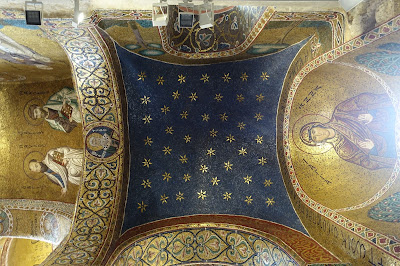I was an exceptionally busy bee on my third day in Palermo. After the
Palatine Chapel,
Norman Palace and the
cathedral including
roof visit, I still had the energy to visit another of Sicily's mosaicked masterpieces, namely Santa Maria dell'Ammiraglio, aka La Martorana.
 |
| Outside La Martorana (on a different day) |
 |
| La Martorana on the left, Chiesa di San Cataldo on the right |
Well, actually, I meant to visit La Martorana, but got confused and first went to the church right next door, the Chiesa di San Cataldo. I had been past San Cataldo before, and there always seemed to be a queue of people waiting to go in (as in the photo above), so I assumed it was the right place. They have a little curtain across the door for the express purpose of tricking people into paying the entrance fee, since inside it is tiny and empty. The outside is cool, but there really is nothing to see in there.
 |
| The sparse interior of San Cataldo |
I sat down for a few moments to get my 2.50€ worth before heading next door to my intended destination. La Martorana is certainly quite the contrast after the bare walls of San Cataldo. Founded in 1143, it is a complete mishmash between the original Arab-Norman style and later largely Baroque additions made between the 16th and 18th century. Of course, it's not uncommon for churches to have this sort of history, but I've rarely seen such a stark divide as in La Martorana. If you're looking for the sort of architectural cohesion of the Palatine Chapel, this is not the place to come, but personally I quite liked the collision of the different styles.
 |
| Mosaics vs. frescoes |
 |
| The Baroque fresoes are mostly at the back of the church, but reappear over the altar |
 |
| The newer back section |
 |
| Mosaic depicting the church's founder, George of Antioch, admiral and principal minister of Roger II, at the foot of the Virgin |
 |
| Martoranaramas |
 |
| Roger II being crowned by Jesus. This kind of depiction was a big deal at the time, since it shows him getting his kingly authority directly from God, not from the Pope. Pretty neat to have a contemporary depiction of him - the church was completed by 1151 (as that's when George of Antioch was buried in it), Roger died in 1154 |






















You would make an excellent guide for old churches in Europe. You've visited so many.
ReplyDeleteThat's probably a job that sounds more fun in the abstract than in real life :)
DeleteYes, you've done a stint of tour-guiding, so you'd know! ;) xx
ReplyDelete